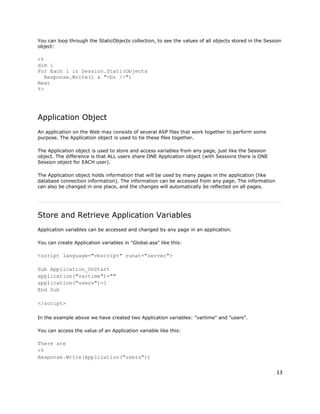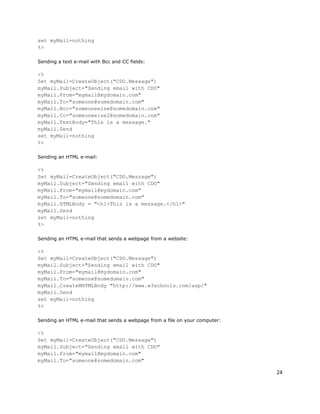- ASP stands for Active Server Pages and is a Microsoft technology that allows web pages to be dynamically generated from server-side script.
- ASP files contain text, HTML, and server-side scripts that are executed by the ASP engine before being returned to the browser as regular HTML.
- Common scripting languages used in ASP include VBScript and JavaScript. Scripts can output content to the browser, access databases, and customize pages for individual users.


















![19
It is possible to create objects with session or application scope in Global.asa by using the <object>
tag.
Note: The <object> tag should be outside the <script> tag!
Syntax
<object runat="server" scope="scope" id="id"
{progid="progID"|classid="classID"}>
....
</object>
Parameter Description
scope Sets the scope of the object (either Session or Application)
id Specifies a unique id for the object
ProgID An id associated with a class id. The format for ProgID is
[Vendor.]Component[.Version]
Either ProgID or ClassID must be specified.
ClassID Specifies a unique id for a COM class object.
Either ProgID or ClassID must be specified.
Examples
The first example creates an object of session scope named "MyAd" by using the ProgID parameter:
<object runat="server" scope="session" id="MyAd" progid="MSWC.AdRotator">
</object>
The second example creates an object of application scope named "MyConnection" by using the
ClassID parameter:
<object runat="server" scope="application" id="MyConnection"
classid="Clsid:8AD3067A-B3FC-11CF-A560-00A0C9081C21">
</object>
The objects declared in the Global.asa file can be used by any script in the application:
GLOBAL.ASA:
<object runat="server" scope="session" id="MyAd" progid="MSWC.AdRotator">
</object>](https://image.slidesharecdn.com/whatisaspallinone-140523220324-phpapp02/85/ASP-19-320.jpg)





